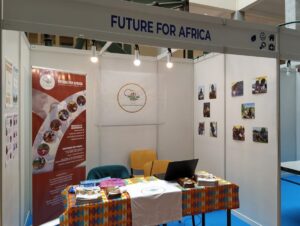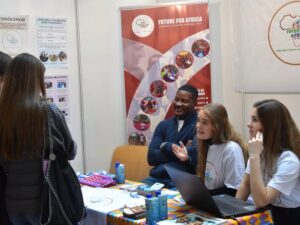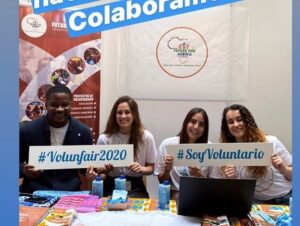Let give girls the chance!




The Future for Africa Health campaign is an initiative to collaborate with
various Health centers and CHPS compounds through the Ghana Health
Service to provide free healthcare services and education to remote
communities with the Upper east region. These are part of efforts by the
organization to promote healthy lifestyles and healthcare awareness among the general public through effective and targeted health education and screening.
Read the entire report here: F4A Health Report 2022


As part of Our social responsibilities to educate and create awareness about the novel corona virus in our community, Our team visited two of our partner basic schools in Bolgatanga namely; Yikene Primary &Junior High School as well as Cameron School Complex to sensitize the school children on the need to continue adhering to all Covid-19 preventive protocols.
During these informative sessions, we stressed on some basic things the school children could do as effort to help reduce the risk of contacting the virus in school and at home. Student were given the opportunity to ask relevant questions to clear their minds on some misconceptions about Covid-19.


We also seized the opportunity share 210 face masks to the students in the two schools.
This exercise was necessitated by the gradual spike in the number of Covid-19 infections in the region and also across the country.
We hope our interaction with these school children helps to create more awareness, spread calm and alertness.




The team was led by our Director, Bawa Mansur Achebs and Project Coordinator- Nayang Samuel.
We wish to mention Maria Almonacid (@merii_cherry) and Cintia Liger (@cintialiger) who are both professional nurses currently working in our health program amidst these uncertain times. For their commitment to share their experiences and also help educate children our community, We say – “Tuuma Tuuma !”

We continue to admonish everyone to keep observing all the safety protocols as we hope things get better in the coming days.

The Future for Africa (F4A), a Non-Governmental Organization (NGO) established in Bolgatanga, the Upper East Regional capital has settled the medical bills of 15 needy children whose parents absconded with them after receiving medical care at the Regional Hospital.
The gesture was part of the NGO’s support to the “Needy Child Fund,” an initiative of the Hospital, which was launched by the Upper East Regional Minister, Madam Paulina Patience Abayage to help sick needy children admitted to the Paediatrics Department who were either not registered onto the National Health Insurance Scheme (NHIS), or had expired NHIS cards.
The NGO apart from the Region extends its philanthropic operations to the Northern and Upper West Regions in areas of health and education to enable communities in these Regions gain access to quality health and education.

In our pursuit to contribute to Community Development, We are committed to providing potable drinking water to communities that need it the most. We have extended our reach to the people of Baare in the Tongo District of the Upper East Region by providing them with a Borehole.


Women and children of this Community used to walk several Kilometers to fetch water for their families. During a short ceremony to hand over the Borehole to the community, the excitement and gratefulness showed by these people tells a lot about how this intervention has come to help the people of Baare community.


Special thanks to @helpingotherss @clogarciacastillo The Garcia Family & Friends (Pilar Alba Pepe, Pilar R. Ramon, Anabel Pedro, Blanca Matais, Matilde Antonio, Paters Alfonso J. Alberto & Grupo Consuegra) for partnering and fully funding this Borehole Project. This particular project comes in as a timely intervention to the people of Baare (most especially the women & children )and other near by communities to help make life easy.Water changes everything , Water is life!








We believe Africa needs more than Charity, what we need most is education, Skill training and empowerment.









13 June is International Albinism Awareness Day, aims to stop the persecution and murders of people with albinism. We wish to use this write-up to create more awareness on the subject and encourage all to treat people living with albinism with love. We also share our story with Ayimpoka. – Written By K. Nayang Samuel (Project Coordinator FUTURE FOR AFRICA)
In Africa the subject of albinism is being trivialized,even though there may be more of them in Africa than in any other continent. According the figures given by the National Organization of Albinism and Hypo-pigmentation (NOAH), about One in every 18,000 to 20,000 people has a form of this skin condition in the United State. In Africa these figures seems to be higher.

Ayimpoka
In South Africa for instance, One out of every 4,000 people has this form of skin condition and perhaps One out of 5,000 people in Nigeria. Tanzania also has a high rate of albino citizens than it is being speculated. According to the BMC Public Health journal, it reported that one out of every 1,400 people has this condition. A country with over 50 Million population, meaning the albino community in Tanzania is about 30,000 but the Albino Association of Tanzania think otherwise, they are of the conviction there could be even more, about 150,000.
These statistics goes to indicate that the albino community forms a significant part of society and hence must to be given the needed reception.
It is however sad that in Africa, the stories about People with Albinism are not always pleasing. This sect of people will not be given the congenial environment to relish their dreams and protect their dignity but are often stereotyped, with an ocean of myths surrounding their physical existence.
Whiles Some people are of the strange belief that Albinos are not born and exist out of thin air, others also nod to the sad notion and speculation that Albinos do not die and hence posses some form of magical powers that make them immortal and live forever. Very Silly perception, isn’t it?
Moreover, it is very fretful to read article stories about how some unscrupulous and obnoxious characters in some parts of Africa, who in the quick to make riches decide to used these vulnerable individuals to perform abominable human sacrifices and rituals.
Body parts of these Albinos are used to quell some gods to make these callous and greedy ingrates rich.
The Ghana Association of persons with Albinism (GAPA) have raised genuine concerns in the past about how some communities in the Brong Ahafo and Eastern Regions of Ghana have wrongfully treated Albinos in these areas. There simply wouldn’t allow people with such conditions to live amongst them.
In a nutshell,Albinism is an inherited genetic condition. It occurs when one of several genes that produces or distribute Melanin is defected. This may be as a result of the absence of melanin production or reduced amount of melanin production. This defective genes may pass down from both parents to the fetus and cause Albinism. The condition is an inherited disorder that is present at birth. The chances that a child being born with Albinism are very eminent if parents of the unborn child are with the condition or perhaps carry the gene for Albinism.
People with this condition usually have an absence of color in the hair, skin and eyes. Their hair, skin, or eyes have lighter colors than normal. They usually have difficulty with vision which may include crossed eyes and photophobia(sensitivity to light). This may also cause a persistent and involuntary rapid movement of the eyes. In worse cases, individuals with the condition may be impaired in vision or probably go blind.
There is no possible cure for this condition, people born with this unfortunately live with this forever. However, people living in hectic climatic regions like Africa can relieve symptoms and prevent excessive sun damage.
There are sunglasses that can be worn to protect the eyes from the suns ultra violet rays. Protective clothing and sunscreens are also available and to guard the skin, and also enhance good vision.
It is very advisable for Albinos to limit their outdoor activities due to the sensitivity of their skin and eyes to the sun. Consistent exposure of the skin to Ultra violet ray may cause skin damage or skin cancer. Vision may also be lost in some people.
OUR STORY
Some few months ago, During our Outreach activities in rural communities, some volunteers spotted a little girl in Sumburugu community a few miles away from our volunteer house at Yikene in Bolgatanga, Ghana.
Ayinpoka is her name, a beautiful Albino girl. She is Four year old and the last born of four. Her elder brother who is second of the Four children has a similar condition. By inexplicable happenstance her two other elder siblings are without the condition.
Their parents however, are also not with the condition. Even though they are not Albinos but the possibility is that they could be carrying the gene for Albinism.

It is very interesting to notice this kind of differences even among members of the same family.
Little Ayinpoka’s story may not be too different from what other Albinos go through in Ghana.
What actually brought Her to our special notice was that, aside her unfortunate state, little Ayinpoka was plagued with sores and blisters which made her very uncomfortable. Her mother explained that, little Ayinpoka was restless most of the time.
Seeing her condition dampened the spirits of those volunteers.It was really bad. They could not let her go, something needed to be done to arrest the situation. Saying bye to Little Ayinpoka that day was very difficult, but we promised to visit again.
We were extremely glad when some volunteers who worked in our health and childcare project decided to help out. Every other day, they visited the little girl. Wounds were thoroughly cleaned and creams applied.
We were ready to make life turn around for little Ayinpoka.
In the case of little Ayinpoka, we realized that, she wasn’t given the proper care for those sores to be treated.
Apparently her parents were completely naive about some of the best and simple measures to relieve Ayinpoka’s pains. Her parents did not take her to clinic often and no sunglasses were provided her to protect her precious eyes,may be her parents couldn’t afford the bills that came with it. But to us,that wasn’t enough reason for the little angel to go through such an ordeal.

Future For Africa decided to make little Ayinpoka a great focus. Future For Africa has taken up a daunting task to see to the welfare of the little angel.
Together with some other well meaning volunteers, we have turned a life around.
Today,little Ayinpoka has been put in school, Her long woes are over and she can now join her other little friends in the classroom.

GOING FORWARD..
The Albino community needs to be embraced as part of our own. They are no different from normal skinned people. Those silly myths and superstitions about their existence are just balderdash and those perceptions must be erased. We need to encourage them to be with us so they do not feel being stigmatized by society. They need all the love and care any other person will need.
People living with this condition should not be totally jilted by society. It is important that Albinos are given the opportunity and integrated into every facet of our societies. So that they can amply grow
It is very important to stress the need to intensify education on the subject of Albinism, To burst all the funny myths about Albinism.
Moreover, lights need to be thrown on available measures to relieve the symptoms of the condition.
Again, it will be expedient for well meaning bodies and organizations, Governments and stakeholders of social development and modernization to rethink, and design policies that will benefit the Albino community and give them the necessary attention either than the status quo.
Structures must be strengthened to promote Green Economy, Accessibility to modern technology and given the right tutelage and training, persons with Albinism will be able to benefit from labor mobility and globalization. Our world is fast growing and developing and we can’t afford to deprive the albino community from this evolution.